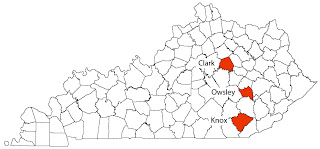Transport and fears of stigma and lack of confidentiality biggest barriers to accessing rural syringe exchanges, study concludes

Counties in study are in red; click on the image to enlarge it.
—–
By Heather Chapman
Kentucky Health News
Rural residents who inject drugs say they are less likely to access syringe exchange programs because of transportation problems, inability to get to the service at times it’s open, and concerns about stigma, lack of confidentiality, and law enforcement. So says a newly published study examining barriers that can prevent people who inject drugs (PWIDs) from accessing syringe service programs (SSPs) in Appalachian Kentucky.
The researchers surveyed 186 PWIDs who used their local health department SSPs in three rural counties in 2018: Clark, Knox and Owsley (though Clark is in a metropolitan area, much of it is rural). Kentucky leads the nation in the number of SSPs, partly because it has 120 counties. As of July 2019, it had 52 SSPs that aim to reduce the spread of HIV and hepatitis C by giving PWIDs clean needles and disposing of dirty ones, and often offer more information about addiction treatment services when the person is ready.
Among the study’s participants, 53.2 percent were male, 92.5% were non-Hispanic whites, and 78.5% had Medicaid coverage. About 39% said they injected more than one drug; methamphetamine was the single most popular drug, with 45.2% reporting it as the primary drug they inject. The next most popular was non-prescribed buprenorphine, which is sold legally as Suboxone for drug treatment (25.8%), followed by heroin (16.1%), other non-prescribed opioids (11.3%), and various other drugs (1.6%).
The biggest barrier to SSP use was the lack of transportation, with 18.3% reporting it as the primary barrier. Other barriers were: inability to access the program during operating hours, which are often limited (12.9%); concerns about stigma, privacy, and/or law enforcement (9.1%), not enough syringes (5.4%); and the location of the program (4.8%).
Participants’ concerns varied based on the degree of their county’s rurality. In Clark and Knox counties, the least rural, transportation was the most frequently cited barrier. But in Owsley, the most rural county, fear of stigma and lack of confidentiality ranked highest.
Rurality also factored into participants’ consistency in accessing the SSPs. Participants in Knox and Owsley were more likely to consistently use the program than participants in Clark. The researchers believe the more consistent uptake in rural areas is because people in rural areas tend to have higher residential stability. However, Clark County participants may be less likely to consistently use SSPs because they’re more likely to have an alternate means of accessing clean needles.
The study is part of a larger National Institutes of Health-funded effort to learn about SSP uptake in rural areas. This study’s authors recently published another study about PWIDs in the same three counties, focused on what kind of interventions are most effective and which drug users are most likely to seek treatment.